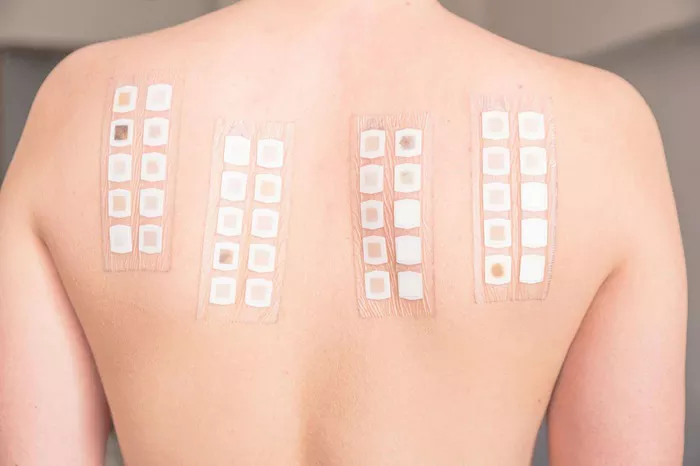Patch testing is a common procedure used in dermatology to diagnose allergic contact dermatitis – a type of skin reaction caused by exposure to specific allergens or irritants. By applying small amounts of potential allergens to the skin and observing for reactions, dermatologists can identify the substances responsible for triggering allergic reactions and provide personalized treatment recommendations. In this comprehensive article, we delve into the intricacies of patch testing, exploring its purpose, procedure, interpretation, and significance in the field of dermatology.
Understanding Allergic Contact Dermatitis
Before delving into the specifics of patch testing, it’s essential to understand the nature of allergic contact dermatitis and how it differs from other types of skin reactions. Allergic contact dermatitis is a delayed hypersensitivity reaction that occurs when the skin comes into contact with substances to which an individual is allergic. Unlike immediate hypersensitivity reactions, such as those seen in allergic reactions to food or insect stings, allergic contact dermatitis typically develops hours to days after exposure to the allergen.
Common allergens that can trigger allergic contact dermatitis include:
Nickel: Found in jewelry, metal snaps, buttons, and zippers.
Fragrances: Found in perfumes, cosmetics, and personal care products.
Preservatives: Found in skincare products, topical medications, and household products.
Rubber: Found in gloves, elastic bands, and footwear.
Dyes: Found in textiles, clothing, and hair dyes.
When the skin is exposed to these allergens, the body’s immune system mounts an inflammatory response, leading to symptoms such as redness, swelling, itching, and blistering at the site of contact.
Purpose of Patch Testing
Patch testing serves as a diagnostic tool to identify the specific allergens responsible for triggering allergic contact dermatitis in individual patients. By exposing the skin to a comprehensive panel of potential allergens, dermatologists can determine which substances elicit allergic reactions and tailor treatment recommendations accordingly. The primary goals of patch testing include:
Identifying Allergens: Patch testing helps dermatologists pinpoint the specific allergens that are causing allergic contact dermatitis in patients, allowing for targeted avoidance strategies and allergen-specific treatment recommendations.
Personalizing Treatment: Armed with information about the allergens to which a patient is sensitized, dermatologists can recommend personalized treatment approaches, such as avoiding exposure to specific allergens, using hypoallergenic products, or undergoing desensitization therapy.
Preventing Recurrence: By identifying and eliminating the allergens responsible for triggering allergic contact dermatitis, patch testing can help prevent future flare-ups and minimize the risk of recurrent skin reactions.
Improving Quality of Life: By providing patients with a clear understanding of their allergic triggers and empowering them to take proactive steps to avoid exposure, patch testing can enhance their quality of life and reduce the burden of chronic skin conditions.
The Patch Testing Procedure
The patch testing procedure typically involves several steps, including:
Patient Evaluation: Before performing patch testing, dermatologists conduct a thorough medical history and physical examination to assess the patient’s symptoms, skin condition, and potential allergen exposures. Patients are asked about their occupation, hobbies, skincare routines, and previous allergic reactions to identify possible allergens.
Allergen Selection: Based on the patient’s history and suspected allergens, dermatologists select a panel of allergens for testing. Common allergens included in patch test panels may vary depending on geographic location, occupation, and personal factors.
Patch Application: Small amounts of each selected allergen are applied to individual patches or chambers, which are then affixed to the patient’s upper back using adhesive tape. The patches remain in place for a specified period, typically 48 hours, during which patients are instructed to avoid getting the patches wet or engaging in activities that may dislodge them.
Patch Removal and Reading: After the specified period, the patches are removed, and the skin is evaluated for signs of allergic reactions. Dermatologists examine the skin for erythema (redness), induration (swelling), papules (bumps), vesicles (blisters), and other signs of inflammation at each patch site.
Interpretation and Diagnosis: The results of patch testing are interpreted based on the presence and severity of reactions at each patch site. Positive reactions indicate sensitization to specific allergens, while negative reactions suggest that the allergens tested are unlikely to be responsible for the patient’s symptoms.
Follow-Up and Recommendations: Based on the results of patch testing, dermatologists provide patients with personalized recommendations for allergen avoidance, skincare products, and treatment options. Follow-up appointments may be scheduled to monitor the patient’s progress and adjust treatment as needed.
Interpreting Patch Test Results
Patch test results are interpreted based on the presence and severity of reactions at each patch site. The American Contact Dermatitis Society (ACDS) has established standardized criteria for interpreting patch test reactions, including:
Negative Reaction: No visible reaction or only faint erythema (redness) at the patch site.
Irritant Reaction: Nonallergic irritation of the skin characterized by erythema, edema (swelling), and possibly vesiculation (blistering) at the patch site. Irritant reactions may occur in response to the patch material or test substance itself and are not indicative of allergic sensitization.
Weak Positive Reaction: Mild erythema and/or papules at the patch site, indicating possible sensitization to the test substance. Weak positive reactions are considered clinically relevant if they occur in areas of expected exposure and correlate with the patient’s symptoms.
Strong Positive Reaction: Moderate to severe erythema, induration, and/or vesiculation at the patch site, indicative of significant sensitization to the test substance. Strong positive reactions are considered clinically relevant if they occur in areas of expected exposure and correlate with the patient’s symptoms.
Significance of Patch Testing in Dermatology
Patch testing plays a crucial role in the diagnosis and management of allergic contact dermatitis, providing dermatologists with valuable insights into the specific allergens responsible for triggering skin reactions in individual patients. By identifying allergens and implementing targeted avoidance strategies, dermatologists can help patients manage their symptoms, prevent recurrences, and improve their quality of life.
In addition to its diagnostic utility, patch testing contributes to the field of dermatology by:
Advancing Research: Patch testing data contribute to ongoing research efforts aimed at identifying emerging allergens, understanding patterns of sensitization, and improving diagnostic accuracy and treatment outcomes.
Educating Patients: Patch testing empowers patients with knowledge about their allergic triggers and enables them to make informed decisions about skincare products, occupational exposures, and lifestyle modifications to minimize the risk of allergic reactions.
Guiding Product Development: Patch testing results inform the development of hypoallergenic skincare products, textiles, cosmetics, and other consumer goods, helping manufacturers formulate products that are less likely to cause allergic contact dermatitis.
Informing Public Health Policies: Patch testing data may inform public health policies and regulations related to allergen labeling, occupational safety standards, and environmental exposures, contributing to efforts to protect public health and reduce the burden of allergic skin diseases.
Conclusion
In conclusion, patch testing is a valuable diagnostic tool used in dermatology to identify allergens responsible for triggering allergic contact dermatitis in individual patients. By exposing the skin to potential allergens and observing for reactions, dermatologists can pinpoint specific triggers, tailor treatment recommendations, and empower patients to manage their symptoms effectively.
Patch testing plays a crucial role in improving patient outcomes, advancing research efforts, educating patients, guiding product development, and informing public health policies related to allergen exposure. By incorporating patch testing into clinical practice, dermatologists can enhance their diagnostic capabilities, optimize treatment strategies, and ultimately improve the quality of life for individuals with allergic contact dermatitis.
[inline_related_posts title=”You Might Be Interested In” title_align=”left” style=”list” number=”6″ align=”none” ids=”8645,8637,8559″ by=”categories” orderby=”rand” order=”DESC” hide_thumb=”no” thumb_right=”no” views=”no” date=”yes” grid_columns=”2″ post_type=”” tax=””]

































